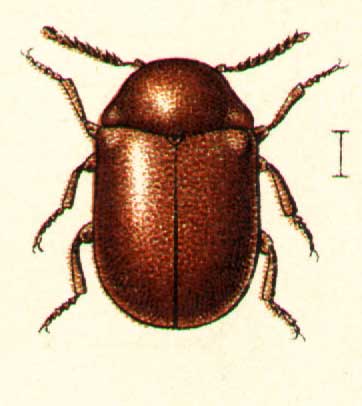
Superregnum: Eukaryota
Cladus: Unikonta
Cladus: Opisthokonta
Cladus: Holozoa
Regnum: Animalia
Subregnum: Eumetazoa
Cladus: Bilateria
Cladus: Nephrozoa
Cladus: Protostomia
Cladus: Ecdysozoa
Cladus: Panarthropoda
Phylum: Arthropoda
Subphylum: Hexapoda
Classis: Insecta
Cladus: Dicondylia
Subclassis: Pterygota
Cladus: Metapterygota
Infraclassis: Neoptera
Cladus: Eumetabola
Cladus: Endopterygota
Superordo: Coleopterida
Ordo: Coleoptera
Subordo: Polyphaga
Infraordo: Bostrichiformia
Superfamilia: Bostrichoidea
Familia: Ptinidae
Subfamilia: Xyletininae
Tribus: Lasiodermini
Genus: Lasioderma
Species: Lasioderma serricorne
Name
Lasioderma serricorne (Fabricius, 1792)
References
Español, F. 1979: Anobiidae (Coleoptera) of the Kermadec Islands. New Zealand journal of zoology, 6: 61–67. BUGZ
Tachikawa, T., 1985. Forest Pests, Tokyo, 34(8): 2–4.
Links
Lasioderma serricorne F. (Anobiidae)
Vernacular names
magyar: Dohánybogár
日本語: タバコシバンムシ
português: Besouro-do-fumo
Türkçe: Sigara böceği
Lasioderma serricorne, commonly known as the cigarette beetle, cigar beetle, or tobacco beetle, is an insect very similar in appearance to the drugstore beetle (Stegobium paniceum) and the common furniture beetle (Anobium punctatum). All three species belong to the family Ptinidae.
L. serricorne is around 2–3 mm long, and brown in colour. The beetles, which can fly, live 2–6 weeks and do not feed as adults. They can be distinguished from A. punctatum by the fact that A. punctatum has a thorax with a pronounced "humped" shape. S. paniceum and L. serricorne have thoraces which have a much less obtuse looking angle when viewed from the side compared to A. punctatum, and thus could be difficult to tell apart. However S. paniceum has a distinct three-segmented "club" at the end of each antenna whereas L. serricorne has uniformly serrated antennae of 11 segments. L. serricorne also has much weaker punctures on the surface of the wing covers (elytra) than the other two species.
As indicated by its common name, the cigarette beetle is a pest of tobacco, both in the refined cigarette packet presentation and also as stored in hogsheads and bales, but is also a minor pest of oilcake, oilseeds, cereals, dried fruit, sage, flour, and some animal products.
Life cycle
The female beetle lays around 100 eggs loosely on the substrate to be fed upon. The larvae are active and will move around on and bore into the product, feeding as they go. The complete life cycle takes 26 days at 37 °C and 120 days at 20 °C. L. serricorne cannot tolerate the cold; adults die within 6 days at 4 °C, and eggs survive 5 days at 0–5 °C. The cigarette beetle's larvae can be distinguished with difficulty from the grubs of the drugstore beetle, most easily by their longer hair and dark head capsule.[1]
The beetles carry a symbiotic yeast, Symbiotaphrina kochii, that is transmitted to the next generation superficially on the eggs and carried internally in larvae and adults in the mycetome, a specialized organ that is linked to the gut.[2] The yeast cells assist in the digestion of less nutritious foods, supply needed B-vitamins and sterols, and provide resistance to certain toxins.[3][4]
Infestation
Main article: List of tobacco diseases
Tobacco and its related products can be infested by Lasioderma serricorne and Ephestia elutella (tobacco moth), which are the most widespread and damaging pests for the tobacco industry.[5] Infestation can range from the tobacco cultivated in the fields to the leaves used for manufacturing cigars, cigarillos, cigarettes, etc.[5]
Control in commercial/industrial settings
several views of Lasioderma serricorne specimen
Insect monitoring traps are available for L. serricorne, which contain specific pheromones to attract male beetles, and help detect and monitor infestations. Infested bulk tobacco in the form of bales or hogsheads can be fumigated using methyl bromide or phosphine.
Dosage rates and treatment times with methyl bromide are 20 grams/m3 at 21 °C above and 32 grams/m3 for 48–72 hours at 7–20 °C. Methyl bromide is not recommended for cigar tobacco since it can produce off odours in the product.
With phosphine dosage rates are one gram of phosphine (equivalent to a 3-gram table) per m3 for 5 days at 12–15 °C and 4 days at 16–20 °C and 3 days above 20 °C.
For localised or household-level infestations the preferred control measure is to find the infested product, dispose of it, and treat around the area with a residual insecticide such as cypermethrin to kill off any remaining beetles.
References
Comparison of Lasioderma and Stegobium larvae
Noda H, Kodama K (1996). "Phylogenetic position of yeastlike endosymbionts of anobiid beetles". Appl Environ Microbiol. 62 (1): 162–7. PMC 167783. PMID 8572692.
Dowd PF, Shen SK (1990). "The contribution of symbiotic yeast to toxin resistance of the cigarette beetle (Lasioderma serricorne)". Entomol Exp Appl. 56 (3): 241–8. doi:10.1007/BF00163695.
Nasir H, Noda H (2003). "Yeast-like symbiotes as a sterol source in anobiid beetles (Coleoptera, Anobiidae): possible metabolic pathways from fungal sterols to 7-dehydrocholesterol". Archives of Insect Biochemistry and Physiology. 52 (4): 175–82. doi:10.1002/arch.10079. PMID 12655605.
Ryan, L., ed. (1995). "Introduction". Post-harvest Tobacco Infestation Control. Norwell, Massachusetts and Dordrecht, Netherlands: Kluwer Academic Publishers. pp. 1–4. doi:10.1007/978-94-017-2723-5_1. ISBN 978-94-017-2723-5.
Retrieved from "http://en.wikipedia.org/"
All text is available under the terms of the GNU Free Documentation License

